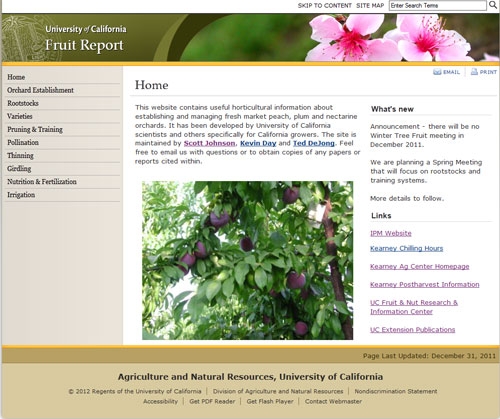A newly redesigned website, the UC Fruit Report, was launched at the beginning of 2012 with comprehensive information for Central Valley tree fruit producers. The website contains research and photos that three UC Cooperative Extension advisors and specialists developed and collected over the past 30 years.
Website visitors will find useful horticultural information about establishing and managing fresh market peach, plum and nectarine orchards. UC pomology specialist Scott Johnson, who is based at the Kearney Agricultural Research and Extension Center, devoted half of his year-long sabbatical in 2011 to aggregating the information online.
“The website has a lot of information that will help farmers,” Johnson said. “If they’re seeing symptoms on their leaves that they think is a nutrient deficiency, they can go into the site and look at pictures and compare. If they’re planning future orchards, they can go through 35 different rootstocks, from dwarfing rootstocks to those that are resistant to certain diseases.”
The basic information on the website is concise and easy to read. The entries include links to detailed research reports for those who wish to explore the topics further.
The site is maintained by Johnson, Tulare County UCCE farm advisor Kevin Day and UC Davis-based pomology specialist Ted De Jong. They will periodically update the website to reflect the newest research findings and post timely news.
“For example, if we’re seeing a problem with mites,” Johnson said. “We can put that up on the web, where farmers can find solutions to the problem.”
Separate sections in the website are devoted to:
- Orchard establishment
- Rootstocks
- Varieties
- Pruning and training
- Pollination
- Thinning
- Girdling
- Nutrition and fertilization
- Irrigation
Attached Images:

The new UC Fruit Report website contains information collected over 30 years.